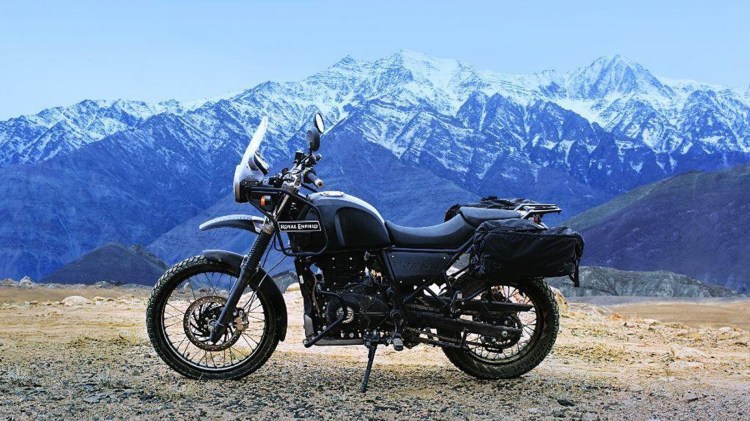Royal Enfield built its first motorcycle in 1901. Its Bullet is said to be the oldest continuously produced motorcycle in the world, and one of the most successful.
But the venerable munitions and motorcycle company, formerly a British legend but now an Indian-owned subsidiary of automotive giant Eicher Group, has had trouble attracting North American buyers.
Despite substantial media push for its classically styled Classic, Bullet and Continental GT models – and substantial motorcycle media attention – the company has been hampered by low visibility and a limited dealer network.
With the just-introduced Himalayan, Royal Enfield is going after the “adventure riding” market, currently one of the fastest-growing niches in the U.S. motorcycle world.
It is especially going after the aspirational adventure rider who doesn’t want the size, heft and manufacturer’s suggested retail price of the full-sized segment leaders, such as the BMW R1200GS, Ducati Multistrada 1200 and Honda African Twin.
It is a noble effort. The Himalayan is compact and lightweight, with a low seat height and rider ergonomics that make it easy to ride. Like its brother Enfields, it is retro-stylish and refreshingly simple in design.
The new bike is powered by an air-cooled, single-cylinder 411cc engine, all new to the company, that makes 25 horsepower and 32 pound-feet of torque.
That’s not much, but it was enough power to drive the Himalayan easily to 65 miles per hour on a highway run, and it was enough power to make an off-road ride entirely manageable – as the bigger, more powerful dual sport bikes sometimes are not.
That horsepower is chain-driven to the rear wheel by a five-speed manual transmission. The engine was fed by a traditional carburetor, on the pre-production model I rode, though the bikes delivered for sale will have electronic fuel injection.
As befits the engine output, the Himalayan is a medium-sized, medium-weight machine. It boasts a 31.4-inch seat height and weighs 401 pounds fully fueled – more than three inches shorter and 100 pounds lighter than the Africa Twin.
Riding on 17-inch rear tires and 21-inch front tires, and outfitted with high handlebars, the Himalayan has a comfortable feel sitting down on the street or standing up in the rough stuff. For the former, the bike has a small windscreen that offers some weather protection, and self-cancelling turn signals – though they didn’t self-cancel on the pre-production unit I rode.
The luggage racks are an aftermarket option. For the latter, it’s equipped with spoked wheels, center stand, high fenders, metal armor to protect the gas tank and even a compass.
The foot-peg rubbers even pop out to expose proper off-road metal pegs – mandatory for a bike with adventure aspirations.
Riders who have dreamed of riding the high passes of India, as I have, will be very attracted by the idea of the Himalayan. Finally, we say, a bike that would be fun to operate on the rugged India passes that contain what are advertised as the world’s highest motorable roads.
In reality, this pre-production version of the Himalayan had some issues.
Though the bike boasts a fair 8.7-inch ground clearance, the suspension is stiff, clunky and nonadjustable. The foot pegs are either set too narrow, or the gas tank and seat are built too wide, for comfortable stand-up riding – and most off-road riding requires that posture for stability.
More concerning, unlike on almost all modern motorcycles, the foot pegs are welded to the frame. That means that when one of them breaks in a tip-over – and foot pegs are notoriously vulnerable in off-road riding – a new one can’t simply be bolted on without a welder’s assistance.
Moreover, as is not the case on most bikes, the foot pegs fold up quite reluctantly when bumped, which makes them more vulnerable to breaking. (The rider is vulnerable, too. I offer a beautiful, blue-brown, foot-peg-shaped bruise on my leg as evidence.)
The Himalayan is also missing brush guards, which means no hand protection against wind, weather or underbrush.
This Royal Enfield, which will be in dealerships this year, arrives at a good time. A number of motorcycle manufacturers are hoping to grow the adventure riding segment by introducing smaller adventure bikes, among them a BMW 310cc GS, a Kawasaki 300cc Versys, Honda’s new 250cc African Twin-styled 250cc Rally and Suzuki’s promised 250cc V Strom.
There is clear market interest. I have met countless riders who express excitement about adventure riding, but who quail at the size, weight and MSRP of the traditional machines.
Those prospective bike buyers will be attracted to the Himalayan, especially if it comes with an appealing price. Royal Enfield has not set the MSRP yet, but says it will be “consistent with our existing models,” which means as low as $4,999 for a Bullet and as high as $5,999 for a Continental GT.
That’s not nearly what it would cost to acquire a full-size adventure bike, but it could be steep for buyers who may be looking at a small-bore BMW, Honda, Kawasaki or Suzuki for under $5,000.
Royal Enfield sold about 675,000 motorcycles worldwide in 2016, according to Rod Copes, president of Royal Enfield North America. Only 450 of them were sold in North America.
Send questions/comments to the editors.



Success. Please wait for the page to reload. If the page does not reload within 5 seconds, please refresh the page.
Enter your email and password to access comments.
Hi, to comment on stories you must . This profile is in addition to your subscription and website login.
Already have a commenting profile? .
Invalid username/password.
Please check your email to confirm and complete your registration.
Only subscribers are eligible to post comments. Please subscribe or login first for digital access. Here’s why.
Use the form below to reset your password. When you've submitted your account email, we will send an email with a reset code.